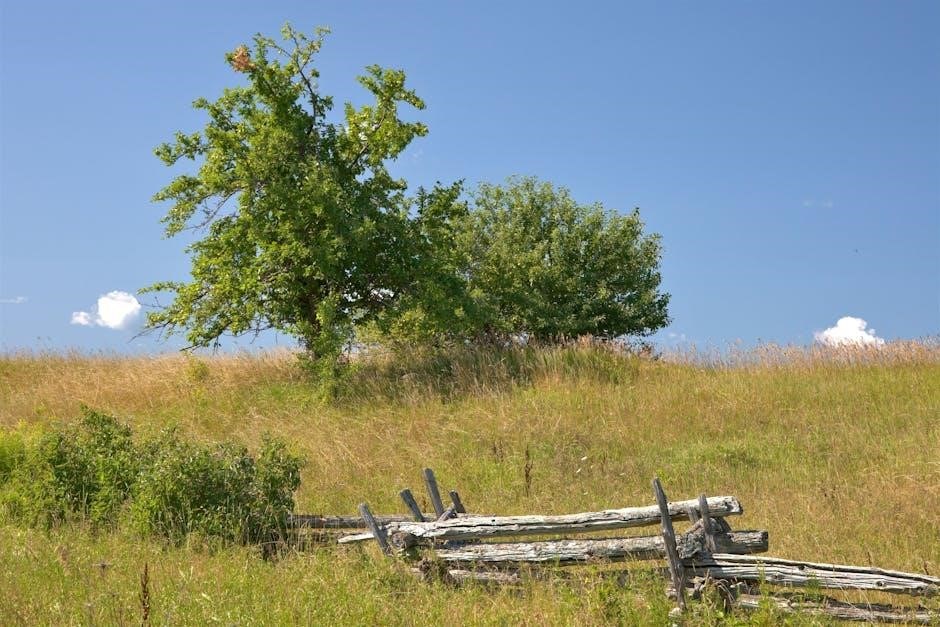This comprehensive guide, published by the Royal Ontario Museum, explores Ontario’s diverse tree species, featuring over 1,400 vibrant photographs and detailed descriptions for accurate identification.
Purpose and Scope of the Guide
The Field Guide to Trees of Ontario aims to provide a comprehensive resource for identifying and understanding the diverse tree species found across the province. Published by the Royal Ontario Museum, it covers over 200 native and naturalized species, offering detailed descriptions, vibrant photographs, and practical identification tools. Designed for both experts and novices, the guide enables users to recognize trees in various settings, from urban streets to forested landscapes.
Its scope includes diagnostic features, distribution maps, and seasonal variations, making it an essential tool for nature enthusiasts, educators, and conservationists. The guide emphasizes the importance of trees in Ontario’s ecosystems and supports efforts in biodiversity and environmental stewardship.
How to Use the Guide Effectively
To maximize the utility of the Field Guide to Trees of Ontario, begin by familiarizing yourself with its organization, which includes sections for coniferous and deciduous trees. Utilize the detailed index or table of contents to navigate effortlessly. Pay special attention to the identification keys, which provide a systematic approach to determining species based on characteristics like leaf shape and bark patterns. Focus on diagnostic descriptions that highlight distinctive features, such as vibrant fall colors or unique bark textures, to aid in quick recognition. Additionally, leverage the guide’s seasonal variations section to accurately identify trees throughout the year, considering differences in appearance from spring to winter. The over 1,400 photographs offer comparative visuals for distinguishing between similar species. For beginners, starting with common species and specific habitats can enhance the learning experience. While the guide is compact for portability, its concise format requires careful navigation to fully appreciate the detailed information. By practicing with known species and gradually tackling more complex identifications, users can build proficiency and confidence in tree identification.

Identifying Trees in Ontario
Ontario’s diverse landscape hosts a wide variety of tree species, from towering conifers to vibrant deciduous trees, each with unique characteristics for accurate identification;
Visual Identification Methods
Visual identification is a cornerstone of the Field Guide to Trees of Ontario, relying on detailed observations of tree features. Key methods include examining leaf shape, arrangement, and venation, as well as bark patterns and textures. Photographs and illustrations highlight distinctive characteristics, such as the lobed leaves of maples or the needle clusters of pines. The guide also emphasizes seasonal changes, like flower blooms in spring and vibrant fall colors. By focusing on these visual cues, users can accurately identify species in both natural and urban settings, making it accessible for all skill levels.
Descriptive Characteristics for Accurate Identification
The guide emphasizes detailed descriptive characteristics to aid in precise tree identification. Key features include leaf venation patterns, bark textures, and fruit or flower details. Vibrant photographs and illustrations highlight these traits, enabling users to distinguish between similar species. Seasonal variations, such as spring blooms or autumn foliage, are also described to ensure accurate recognition. This approach caters to both novice and experienced observers, providing a thorough understanding of Ontario’s diverse tree species and their unique attributes.
Coniferous Trees of Ontario
Ontario’s coniferous trees include pines, spruces, and firs, known for their needle-like leaves and cones. These evergreens thrive in diverse habitats, providing year-round greenery and ecological balance.
Common Species and Their Distinctive Features
Ontario’s coniferous trees include iconic species like the Eastern White Pine, known for its long, soft needles in bundles of five, and the Red Pine, recognizable by its shorter needles in pairs and reddish-brown bark. The White Spruce and Black Spruce are distinguished by their sharp, square needles and conical shapes, while the Balsam Fir is notable for its fragrant aroma and upright cones. These species are integral to Ontario’s forests, offering unique characteristics for identification and ecological significance.
Identification Tips for Conifers
Identifying conifers in Ontario can be done by observing their needles, cones, bark, and growth patterns. Examine needle length, arrangement, and texture—soft and flexible for pines, sharp and bundled for spruces. Note cone shapes and positions, as they often distinguish species. Bark patterns, such as furrowed or scaly textures, also aid identification. Seasonal changes, like spring coloration or winter foliage, provide additional clues. Using detailed field guides with photographs and descriptions ensures accurate identification of Ontario’s diverse conifer species.

Deciduous Trees of Ontario
Deciduous trees in Ontario showcase stunning seasonal transformations, from spring blooms to vibrant fall colors. Iconic species like maples and oaks dominate the landscape, adapting to the province’s climate.
Prominent Species and Seasonal Changes
Ontario’s deciduous trees, such as sugar maple, red maple, and white oak, are renowned for their vibrant seasonal transformations. Spring brings blooming flowers and fresh foliage, while summer offers dense canopies providing shade. Autumn is marked by spectacular color displays, with hues of orange, red, and yellow. These species adapt resiliently to the province’s climate, making them ecologically vital and aesthetically cherished throughout the year.

Key Differences Between Deciduous and Coniferous Trees
Deciduous trees shed their leaves annually, while coniferous trees retain needle-like foliage year-round. Deciduous species, like sugar maple, display vibrant seasonal changes, while conifers, such as eastern white pine, maintain greenery. Growth habits differ too: deciduous trees often form broad canopies, whereas conifers have more uniform, dense structures. These distinctions influence their ecological roles, with deciduous trees adapting to seasonal cycles and conifers thriving in colder, nutrient-poor environments, each contributing uniquely to Ontario’s diverse landscapes.
Tree Identification by Leaves
Leaves are key identifiers, with shape, arrangement, and venation providing critical clues. Observing these features helps distinguish species effectively in Ontario’s diverse tree population.
Leaf Shape, Arrangement, and Venation
Leaf shape, arrangement, and venation are critical for tree identification. Shapes vary from ovate to lanceolate, while arrangements like alternate, opposite, or whorled provide distinct patterns. Venation, the vein structure, can be pinnate or palmate, further aiding identification. These features, often unique to species, help differentiate even similar-looking trees. Observing these details ensures accurate identification, making leaves one of the most reliable tools for tree enthusiasts and experts alike in Ontario’s diverse flora.
Using Leaf Characteristics for Accurate Identification
Leaf characteristics are essential for identifying tree species. By examining shape, size, and margin details like lobes or teeth, enthusiasts can narrow down species. Venation patterns and arrangements, such as alternate or opposite, further refine identification. Comparing leaves to illustrated guides or photographs helps confirm species. Seasonal changes in leaf color and texture also provide clues. This method, combined with habitat observations, ensures precise and accurate tree identification, making leaves a cornerstone of botanical fieldwork in Ontario’s diverse ecosystems.

Tree Identification by Bark and Flowers
Bark patterns and textures, along with flower and fruit characteristics, provide unique identifiers for tree species, aiding in accurate recognition and differentiation in Ontario’s diverse flora.
Bark Patterns and Textures
Bark patterns and textures are essential for identifying tree species, especially during winter when leaves are absent. Smooth, scaly, ridged, or papery bark provides unique clues. For instance, the White Birch features papery, peeling bark, while the White Pine has reddish-brown, scaly bark. These characteristics vary with age and environmental conditions, making them reliable identifiers. Detailed photographs and descriptions in the guide highlight these distinctive features, aiding enthusiasts in accurately recognizing Ontario’s diverse tree species throughout the year.
Role of Flowers and Fruits in Tree Identification
Flowers and fruits play a crucial role in tree identification, offering distinct characteristics that leaves alone may not provide. Brightly colored flowers, such as those of the Tulip Tree, or unique fruit structures, like the acorns of oaks, serve as reliable identifiers. The guide highlights these features with detailed descriptions and images, making it easier to distinguish species. This focus on reproductive structures complements leaf-based identification, providing a comprehensive approach to recognizing Ontario’s tree species throughout the growing season.
Tree Identification by Size and Habitat
Tree size and habitat are key factors in identification. Ontario’s trees vary from small shrubs to towering species, often thriving in specific environments like wetlands or urban areas.
Understanding Tree Growth Habitats
Ontario’s diverse landscapes support various tree habitats, from northern forests to southern woodlands. Trees thrive in specific environments based on soil type, moisture levels, and sunlight exposure. For instance, conifers like spruce and pine prefer well-drained, acidic soils in upland areas, while deciduous species such as willow and alder often flourish in wetlands or along riverbanks. Urban trees, like maple and oak, adapt to human-modified environments, showing resilience in cultivated settings. Habitat knowledge aids in predicting which species are likely to grow in a given area, enhancing identification accuracy and ecological understanding.
Size as a Factor in Tree Recognition
Size plays a significant role in identifying Ontario’s trees, as it often correlates with age and species characteristics. Mature trees typically display full-size leaves, flowers, and fruits, aiding identification. For example, the towering eastern white pine can reach over 30 meters, while smaller species like the dwarf birch remain shrub-like. Observing a tree’s height and spread helps narrow down possibilities, especially when other features like bark or needles are less distinctive. This factor is particularly useful in mixed forests where diverse species coexist.
Seasonal Changes in Tree Identification
Seasonal changes offer critical clues for identifying Ontario’s trees, from spring blossoms to autumn foliage and winter bare branches, aiding year-round recognition and study.
Identifying Trees in Spring and Summer
In spring and summer, Ontario’s trees are in full foliage, making leaf, flower, and fruit characteristics key for identification; During these seasons, vibrant blossoms like cherry and apple trees emerge, while maple and oak leaves unfurl. The guide emphasizes using leaf shape, arrangement, and venation to distinguish species. Spring blossoms and summer fruits, such as berries or nuts, provide additional clues. With detailed photographs and descriptions, the guide simplifies recognizing native species, offering a clear pathway for both novices and experts to explore Ontario’s arboreal diversity effectively during these vibrant seasons.
Winter Identification Techniques
Winter tree identification relies on features like bark patterns, bud arrangements, and twig shapes, as leaves are absent. The guide provides detailed photographs and descriptions to distinguish species by these characteristics. Persistent fruits or seeds, such as cones or berry-like structures, also aid in recognition. Diagnostic keys specifically designed for winter conditions help users accurately identify trees without foliage. This section ensures that even in snowy landscapes, Ontario’s tree species remain identifiable, making winter exploration equally rewarding for nature enthusiasts and researchers alike.

Conservation and Management of Ontario’s Trees
Conservation efforts focus on protecting native tree species and addressing threats like invasive insects and climate change. Sourcing native trees from local suppliers supports reforestation and biodiversity.
Importance of Native Tree Species
Native tree species are vital to Ontario’s ecosystems, providing habitat for wildlife and maintaining biodiversity. They adapt naturally to local conditions, ensuring resilience against pests and climate changes. These trees support pollinators, improve water quality, and mitigate soil erosion. Planting native species aids in preserving Ontario’s ecological balance, promoting sustainable forests, and enhancing natural beauty for future generations. Their role in carbon sequestration further underscores their importance in combating climate change.
Threats to Tree Populations and Conservation Efforts
Ontario’s tree populations face threats from climate change, invasive species, urbanization, and diseases like emerald ash borer. Conservation efforts include reforestation, habitat restoration, and sustainable forestry practices. Protecting native species and ecosystems requires collaborative actions, public awareness, and policy support to ensure biodiversity and ecological balance for future generations.
